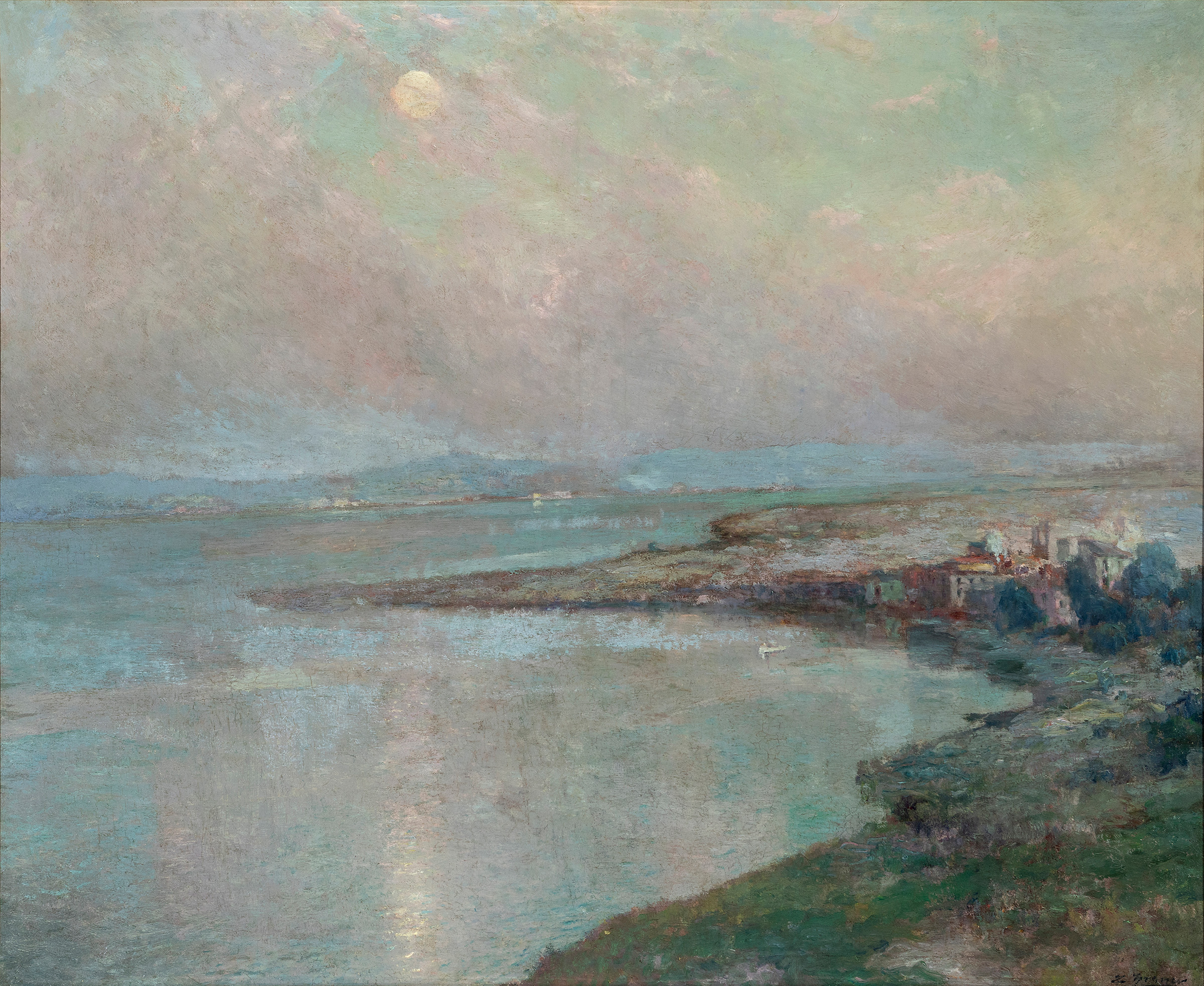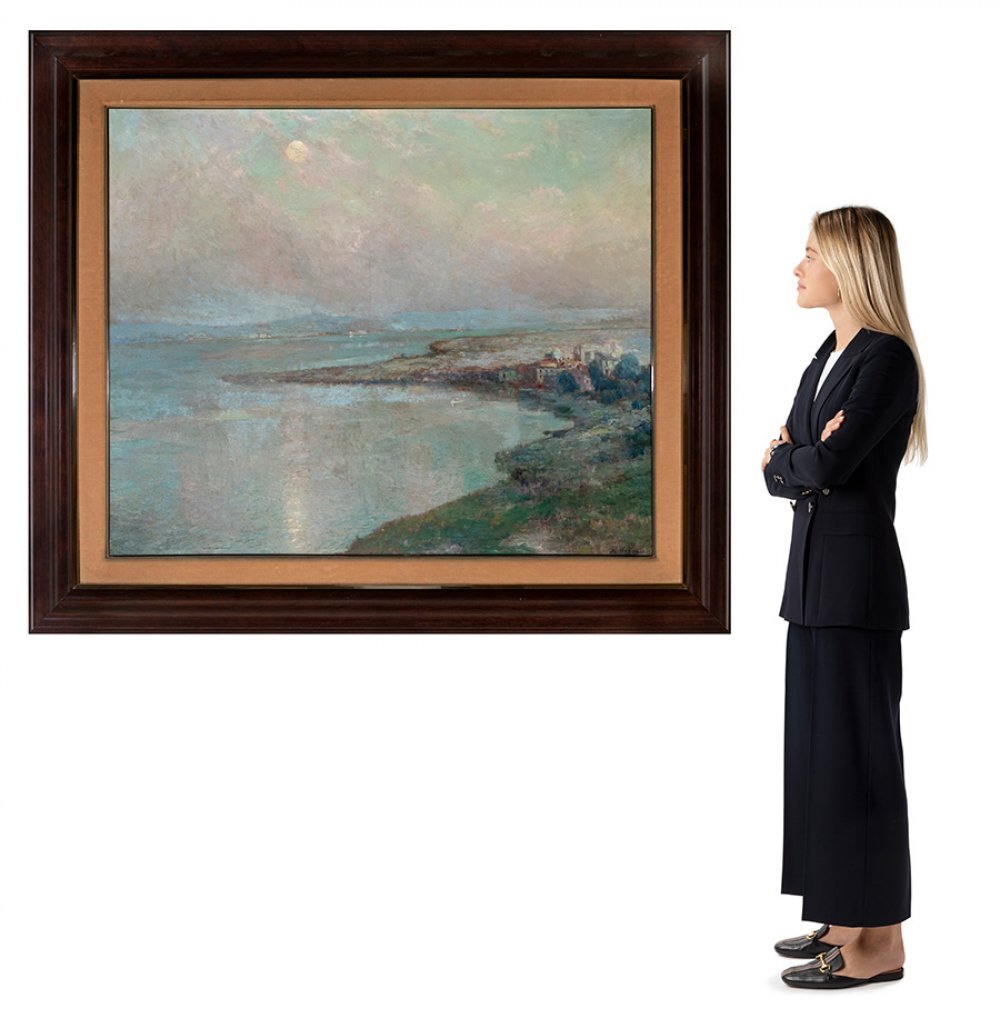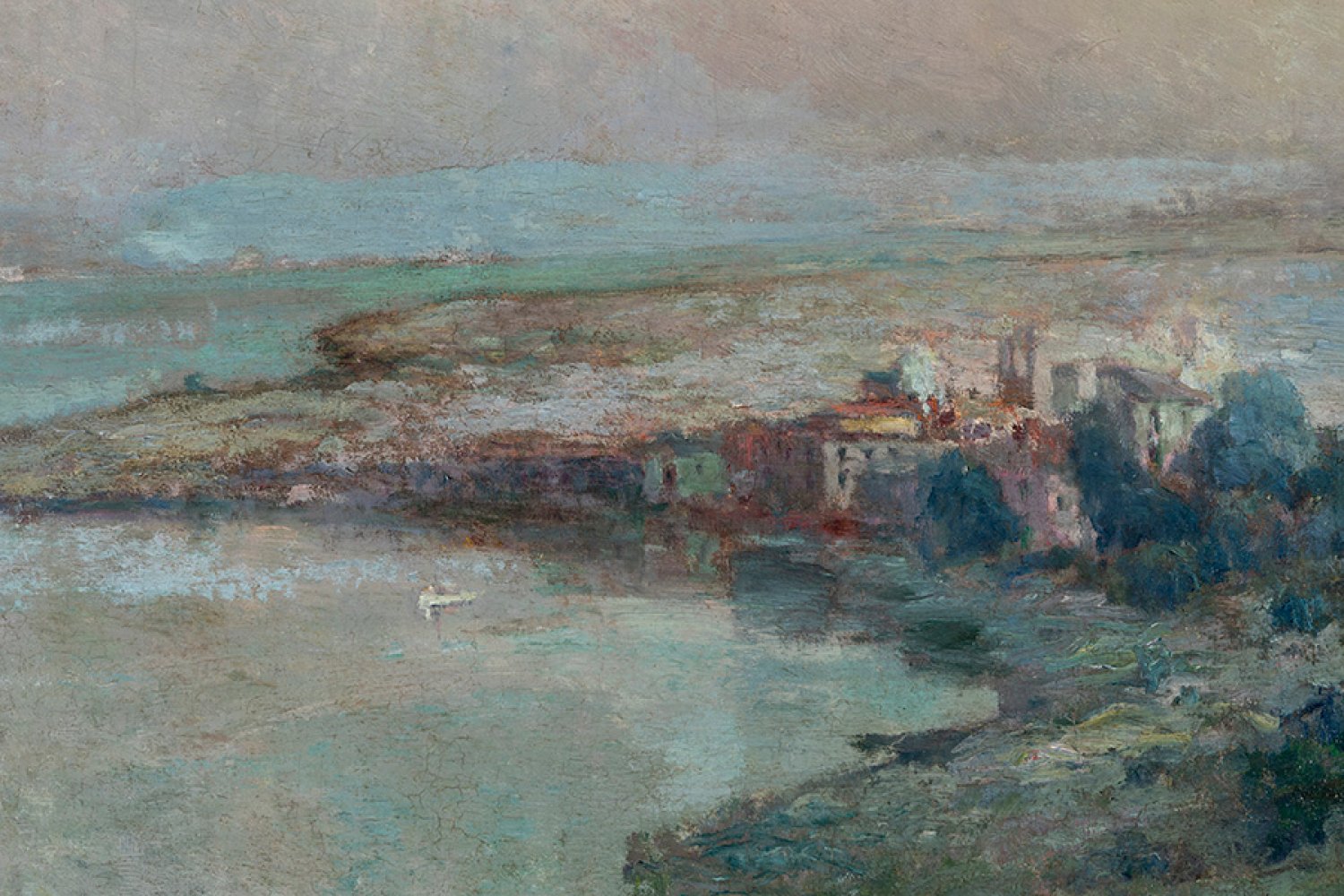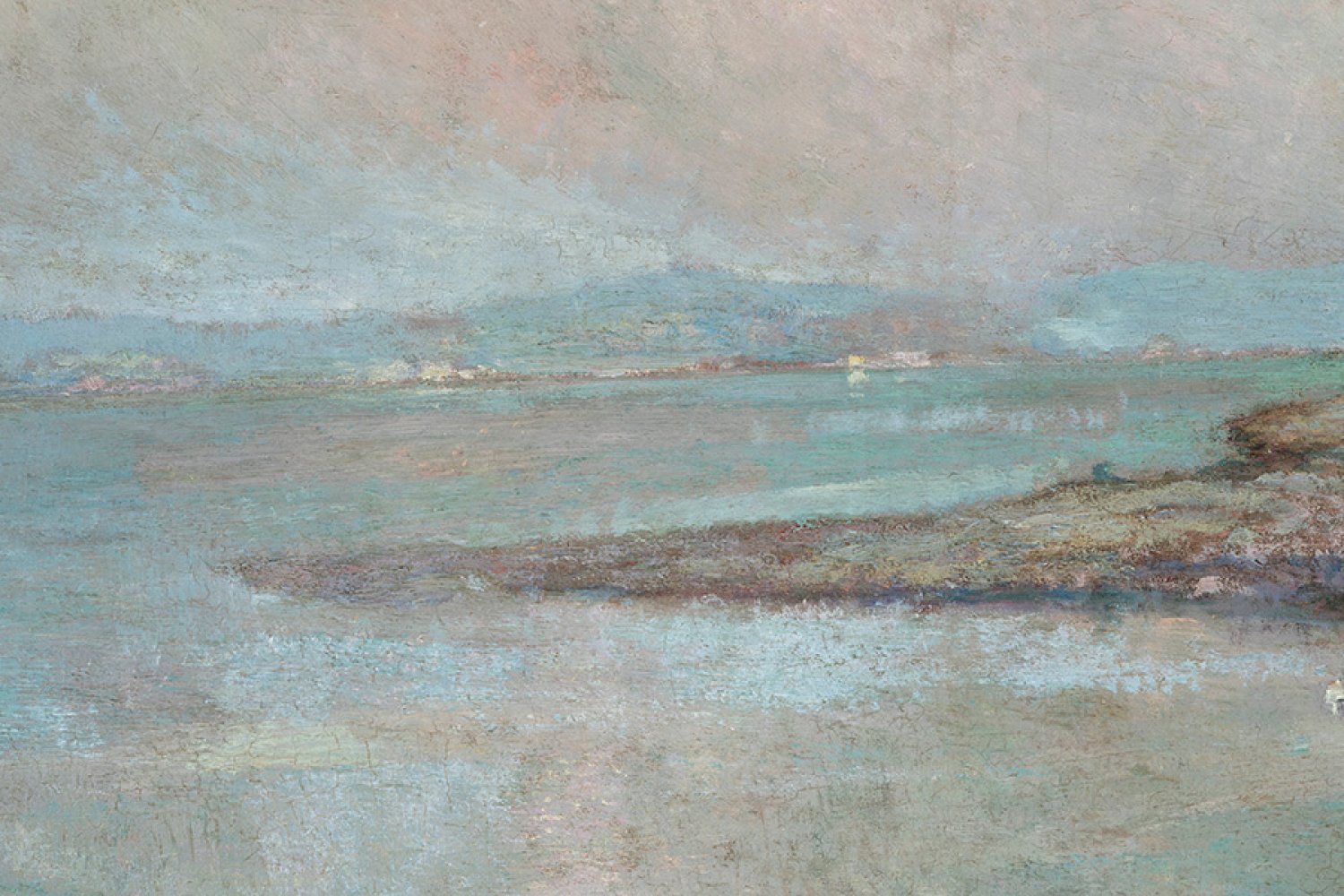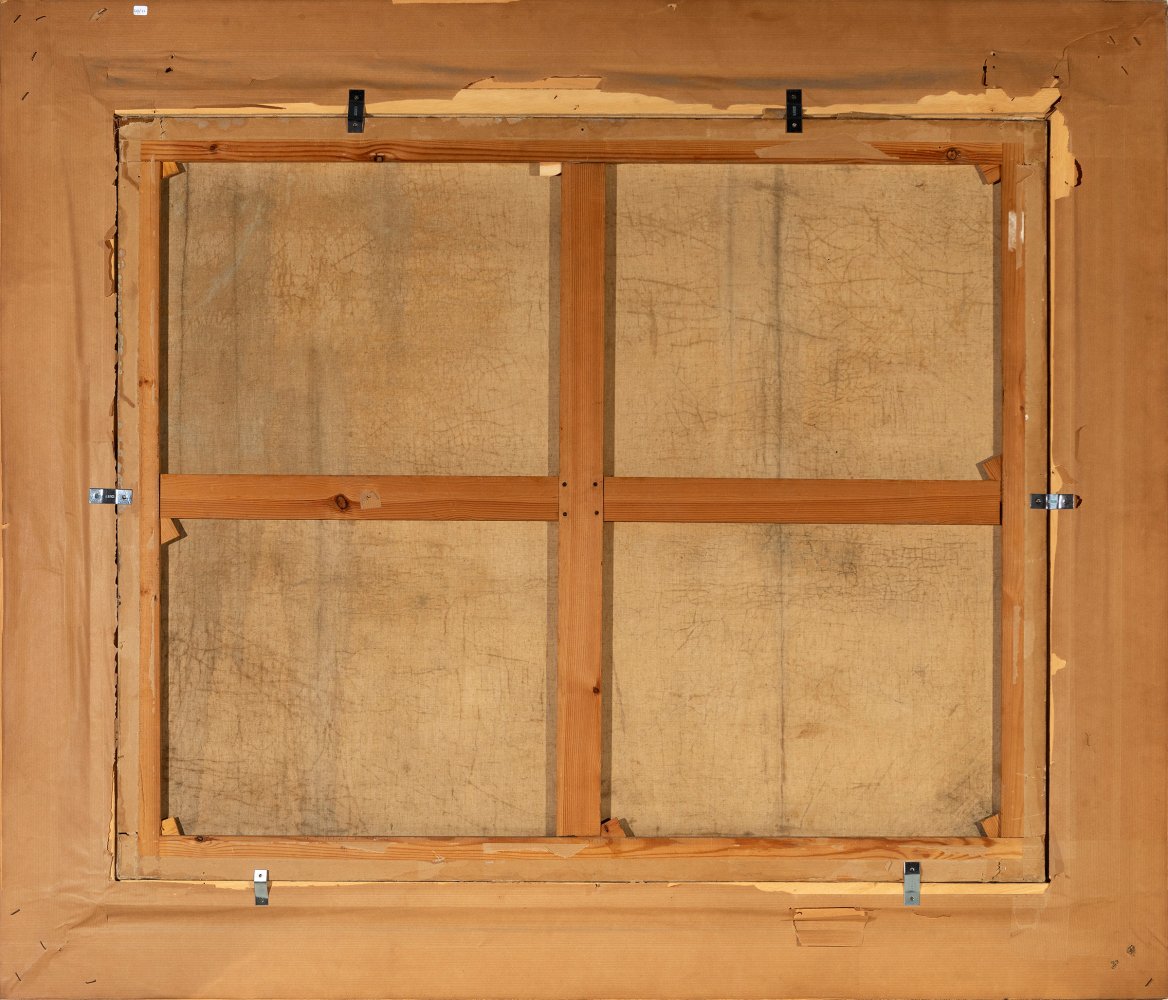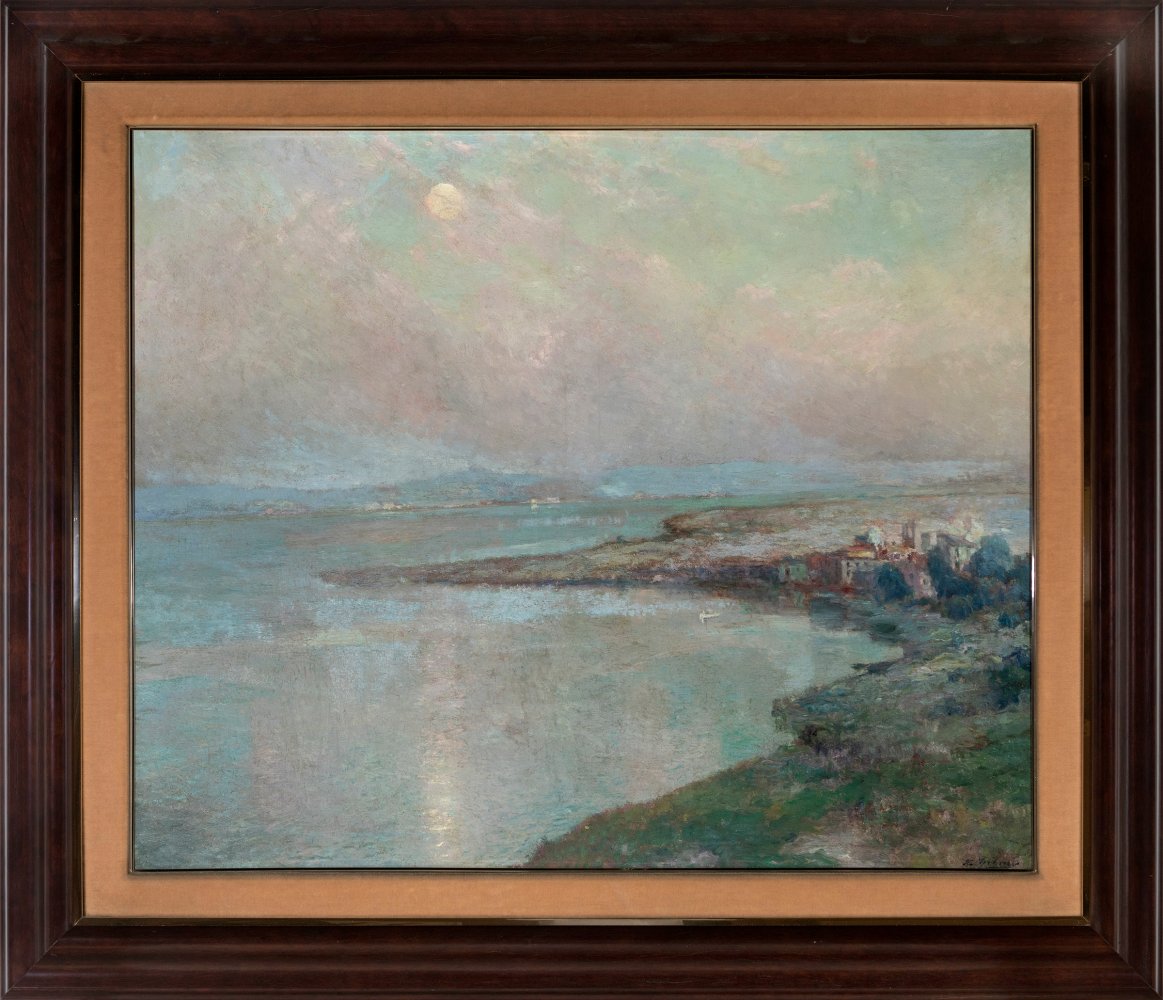4
LUIS GRANER ARRUFÍ (Barcelona, 1863 - 1929)."Coastal landscape".Oil on canvas.Signed in the lower
1/7
Description
LUIS GRANER ARRUFÍ (Barcelona, 1863 - 1929).
"Coastal landscape".
Oil on canvas.
Signed in the lower right-hand corner.
Size: 100,5 x 122,5 cm; 133 x 155,5 cm (frame).
The light was the great protagonist of Lluís Graner's work, both in his paintings of interior, where a quinque lighting illuminates the faces congregated in the half-light of the home, and in landscapes like the one we are dealing with, where a diffuse light reverberates everywhere: filtering from the lightly vaporous sky, it slides along the rippling surface of the sea, making land and sky, horizon and mountain dialogue.
Luis Graner trained at the Escuela de La Lonja in Barcelona, where he was a pupil of Benito Mercadé and Antonio Caba, and in 1886 he moved to Paris thanks to a grant from the Diputació de Barcelona. During his five years in the French capital he won two third place medals at the Universal Exhibitions of Barcelona (1888) and Paris (1889). Settling back in Barcelona in 1891, he continued to take part in important international exhibitions, such as those of Berlin (1891), Munich (1892) and Düsseldorf (1904). He also submitted works to the National Fine Arts Exhibitions, winning third medals in 1895 and 1897, second in 1901 and a decoration in 1904. That same year Graner created the Sala Mercè, designed by Gaudí, where he organised his "musical visions", shows that combined poetry with music, scenography with cinema. Collaborating with him at this stage were Adrià Gual as director of the performances and Segundo de Chomón, as well as well-known poets (Verdaguer, Carner), musicians (Morera, Lambert) and contemporary stage designers (Moragas, Alarma). At the same time, Graner organised the first talkies, using the technique of placing actors behind the screen to lend their voices. Finally, ruined, he moved to America, where he returned to painting. He made several trips around the United States and Latin America, spending most of his time between New York, where he painted his first solo exhibition in 1910, and California. In 1928 he returned to Barcelona shortly before his death. His paintings, realistic in form, depict the everyday life of humble people, although he also painted landscapes and portraits. In his interior scenes he showed a profound influence of Latour, learned in his Parisian years, which led him to focus on the expressiveness of artificial light. Specialising in genre painting, he also produced landscapes and portraits. His work can be found in the Prado Museum, the MACBA in Barcelona, the National Art Museum of Catalonia, the Hispanic Society in New York and the Balaguer Museum in Vilanova i la Geltrú, among others, as well as in important private Catalan collections.
"Coastal landscape".
Oil on canvas.
Signed in the lower right-hand corner.
Size: 100,5 x 122,5 cm; 133 x 155,5 cm (frame).
The light was the great protagonist of Lluís Graner's work, both in his paintings of interior, where a quinque lighting illuminates the faces congregated in the half-light of the home, and in landscapes like the one we are dealing with, where a diffuse light reverberates everywhere: filtering from the lightly vaporous sky, it slides along the rippling surface of the sea, making land and sky, horizon and mountain dialogue.
Luis Graner trained at the Escuela de La Lonja in Barcelona, where he was a pupil of Benito Mercadé and Antonio Caba, and in 1886 he moved to Paris thanks to a grant from the Diputació de Barcelona. During his five years in the French capital he won two third place medals at the Universal Exhibitions of Barcelona (1888) and Paris (1889). Settling back in Barcelona in 1891, he continued to take part in important international exhibitions, such as those of Berlin (1891), Munich (1892) and Düsseldorf (1904). He also submitted works to the National Fine Arts Exhibitions, winning third medals in 1895 and 1897, second in 1901 and a decoration in 1904. That same year Graner created the Sala Mercè, designed by Gaudí, where he organised his "musical visions", shows that combined poetry with music, scenography with cinema. Collaborating with him at this stage were Adrià Gual as director of the performances and Segundo de Chomón, as well as well-known poets (Verdaguer, Carner), musicians (Morera, Lambert) and contemporary stage designers (Moragas, Alarma). At the same time, Graner organised the first talkies, using the technique of placing actors behind the screen to lend their voices. Finally, ruined, he moved to America, where he returned to painting. He made several trips around the United States and Latin America, spending most of his time between New York, where he painted his first solo exhibition in 1910, and California. In 1928 he returned to Barcelona shortly before his death. His paintings, realistic in form, depict the everyday life of humble people, although he also painted landscapes and portraits. In his interior scenes he showed a profound influence of Latour, learned in his Parisian years, which led him to focus on the expressiveness of artificial light. Specialising in genre painting, he also produced landscapes and portraits. His work can be found in the Prado Museum, the MACBA in Barcelona, the National Art Museum of Catalonia, the Hispanic Society in New York and the Balaguer Museum in Vilanova i la Geltrú, among others, as well as in important private Catalan collections.
Auction Details
Shipping
T&Cs & Important Info
Ask seller a question
LUIS GRANER ARRUFÍ (Barcelona, 1863 - 1929).
"Coastal landscape".
Oil on canvas.
Signed in the lower right-hand corner.
Size: 100,5 x 122,5 cm; 133 x 155,5 cm (frame).
The light was the great protagonist of Lluís Graner's work, both in his paintings of interior, where a quinque lighting illuminates the faces congregated in the half-light of the home, and in landscapes like the one we are dealing with, where a diffuse light reverberates everywhere: filtering from the lightly vaporous sky, it slides along the rippling surface of the sea, making land and sky, horizon and mountain dialogue.
Luis Graner trained at the Escuela de La Lonja in Barcelona, where he was a pupil of Benito Mercadé and Antonio Caba, and in 1886 he moved to Paris thanks to a grant from the Diputació de Barcelona. During his five years in the French capital he won two third place medals at the Universal Exhibitions of Barcelona (1888) and Paris (1889). Settling back in Barcelona in 1891, he continued to take part in important international exhibitions, such as those of Berlin (1891), Munich (1892) and Düsseldorf (1904). He also submitted works to the National Fine Arts Exhibitions, winning third medals in 1895 and 1897, second in 1901 and a decoration in 1904. That same year Graner created the Sala Mercè, designed by Gaudí, where he organised his "musical visions", shows that combined poetry with music, scenography with cinema. Collaborating with him at this stage were Adrià Gual as director of the performances and Segundo de Chomón, as well as well-known poets (Verdaguer, Carner), musicians (Morera, Lambert) and contemporary stage designers (Moragas, Alarma). At the same time, Graner organised the first talkies, using the technique of placing actors behind the screen to lend their voices. Finally, ruined, he moved to America, where he returned to painting. He made several trips around the United States and Latin America, spending most of his time between New York, where he painted his first solo exhibition in 1910, and California. In 1928 he returned to Barcelona shortly before his death. His paintings, realistic in form, depict the everyday life of humble people, although he also painted landscapes and portraits. In his interior scenes he showed a profound influence of Latour, learned in his Parisian years, which led him to focus on the expressiveness of artificial light. Specialising in genre painting, he also produced landscapes and portraits. His work can be found in the Prado Museum, the MACBA in Barcelona, the National Art Museum of Catalonia, the Hispanic Society in New York and the Balaguer Museum in Vilanova i la Geltrú, among others, as well as in important private Catalan collections.
"Coastal landscape".
Oil on canvas.
Signed in the lower right-hand corner.
Size: 100,5 x 122,5 cm; 133 x 155,5 cm (frame).
The light was the great protagonist of Lluís Graner's work, both in his paintings of interior, where a quinque lighting illuminates the faces congregated in the half-light of the home, and in landscapes like the one we are dealing with, where a diffuse light reverberates everywhere: filtering from the lightly vaporous sky, it slides along the rippling surface of the sea, making land and sky, horizon and mountain dialogue.
Luis Graner trained at the Escuela de La Lonja in Barcelona, where he was a pupil of Benito Mercadé and Antonio Caba, and in 1886 he moved to Paris thanks to a grant from the Diputació de Barcelona. During his five years in the French capital he won two third place medals at the Universal Exhibitions of Barcelona (1888) and Paris (1889). Settling back in Barcelona in 1891, he continued to take part in important international exhibitions, such as those of Berlin (1891), Munich (1892) and Düsseldorf (1904). He also submitted works to the National Fine Arts Exhibitions, winning third medals in 1895 and 1897, second in 1901 and a decoration in 1904. That same year Graner created the Sala Mercè, designed by Gaudí, where he organised his "musical visions", shows that combined poetry with music, scenography with cinema. Collaborating with him at this stage were Adrià Gual as director of the performances and Segundo de Chomón, as well as well-known poets (Verdaguer, Carner), musicians (Morera, Lambert) and contemporary stage designers (Moragas, Alarma). At the same time, Graner organised the first talkies, using the technique of placing actors behind the screen to lend their voices. Finally, ruined, he moved to America, where he returned to painting. He made several trips around the United States and Latin America, spending most of his time between New York, where he painted his first solo exhibition in 1910, and California. In 1928 he returned to Barcelona shortly before his death. His paintings, realistic in form, depict the everyday life of humble people, although he also painted landscapes and portraits. In his interior scenes he showed a profound influence of Latour, learned in his Parisian years, which led him to focus on the expressiveness of artificial light. Specialising in genre painting, he also produced landscapes and portraits. His work can be found in the Prado Museum, the MACBA in Barcelona, the National Art Museum of Catalonia, the Hispanic Society in New York and the Balaguer Museum in Vilanova i la Geltrú, among others, as well as in important private Catalan collections.
31st August -19th & 20th Century Arts
Sale Date(s)
Venue Address
Aragón 346, Barcelona
Calle Velázquez 7, Madrid
Carrer de Cirilo Amorós 55, Valencia
Barcelona
08009
Spain
General delivery information available from the auctioneer
Setdart offers Worldwide shipping
PICK UP IN ROOM: You can come and pick up your lots in our offices (Barcelona, Madrid or Valencia). At the moment of the withdrawal, you will be able to accept the current conditions of the lot by means of a document that you will sign.
YOU CAN SEND ANOTHER PERSON TO PICK UP: This person must present a signed authorization that you can find in our web page by accessing from BUY AT SETDART- LOGISTICS-DOWNLOAD AUTHORIZATION DOCUMENT. You can also send an e-mail with the requested data in AUTHORIZATION DOCUMENT to admin@setdart.com
Important Information
25% buyer´s premium
21% buyer´s premium at www.setdart.com















